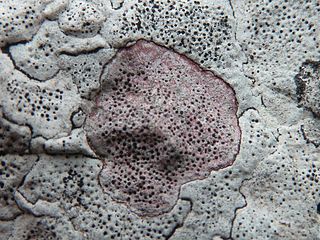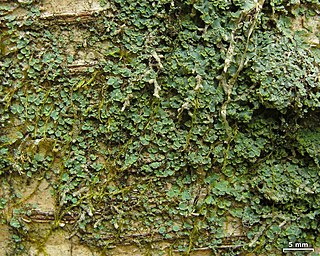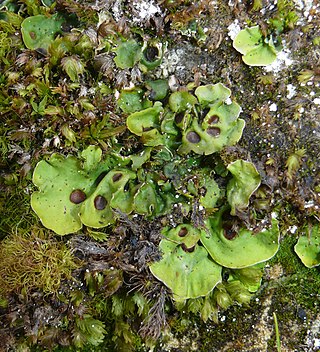
Eurotiomycetes is a large class of ascomycetes with cleistothecial ascocarps within the subphylum Pezizomycotina, currently containing around 3810 species according to the Catalogue of Life. It is the third largest lichenized class, with more than 1200 lichen species that are mostly bitunicate in the formation of asci. It contains most of the fungi previously known morphologically as "Plectomycetes".

Capnodiales is a diverse order of Dothideomycetes, initially based on the family Capnodiaceae, also known as sooty mold fungi. Sooty molds grow as epiphytes, forming masses of black cells on plant leaves and are often associated with the honeydew secreted by insects feeding on plant sap. This diverse order has been expanded by the addition of several families formerly thought unrelated and now also includes saprobes, endophytes, plant pathogens, lichens and rock-inhabiting fungi. The new additions include the genus Mycosphaerella containing the causal agents of several economically important crop and tree diseases. A small number of these fungi are also able to parasitise humans and animals, including species able to colonise human hair shafts.

The Arthoniaceae are a family of lichenized, lichenicolous and saprobic fungi in the order Arthoniales. The Arthoniaceae is the largest family of Arthoniales, with around 800 species. Most species in Arthoniaceae belong in Arthonia which is the largest genus with 500 species. The second and third largest genus is Arthothelium with 80 species, and Cryptothecia with 60 species.

The Dactylosporaceae or Sclerococcaceae are a family of lichen-forming fungi in the class Eurotiomycetes. It is the only family of the order Sclerococcales and subclass Sclerococcomycetidae.

Lichinales is the sole order of ascomycete fungi in the class Lichinomycetes. It contains three families: Gloeoheppiaceae, Lichinaceae, and Peltulaceae. Most species are lichenized. Lichinales was proposed in 1986 by German lichenologists Aino Henssen and Burkhard Büdel. The class Lichinomycetes was created by Valérie Reeb, François Lutzoni and Claude Roux in 2004.
Frutidella is a genus of lichen-forming fungi in the family Ramalinaceae. It contains three species. The genus was circumscribed in 1994 by Klaus Kalb to contain the species formerly known as Lecidea caesioatra.
Seirophora is a genus of lichen-forming fungi in the family Teloschistaceae. It has eight species. The genus was circumscribed by Czech lichenologist Josef Poelt in 1983, with Seirophora magara assigned as the type species. Several species were transferred to Seirophora in 2004 when the genus was emended by Patrik Frödén and Per Lassen to include some species segregated from Teloschistes.

Bagliettoa is a genus of lichen-forming fungi in the family Verrucariaceae. The genus was circumscribed by Italian lichenologist Abramo Bartolommeo Massalongo in 1853. Bagliettoa species are endolithic, growing between the grains of solid rock.

Normandina is a genus of lichen-forming fungi in the family Verrucariaceae. It has five species of crustose and squamulose (scaly) lichens.
Schistophoron is a genus of lichenized fungi in the family Graphidaceae. It contains 5 species.
Punctonora is a genus of lichen-forming fungi in the family Lecanoraceae. The genus was circumscribed in 1997 by lichenologist André Aptroot, with Punctonora nigropulvinata assigned as the type species. A second species was added to the genus in 2018.

Lichina is a genus of lichens in the family Lichinaceae. The genus contains seven species. These cyanolichens include maritime species such as L. pygmaea or L. confinis, in which the associated cyanobiont has been assigned to the genus Rivularia. Furthermore, evidence of a high specificity of each mycobiont towards particular cyanobiont lineages in both species has been detected.

The Lecideaceae are a family of lichens in the order Lecideales.

The Ophioparmaceae are a small family of lichen-forming fungi in the order Umbilicariales. The family was circumscribed in 1988 by lichenologists Roderick Westgarth Rogers and H. Thorsten Lumbsch.
Wegea is a genus of fungi within the order Arthoniales. The genus has not been placed into a family. This is a monotypic genus, containing the single species Wegea tylophorelloides. The genus was circumscribed in 1997 by André Aptroot and Leif Tibell. The species have a morphology similar to calicioid fungi but does not form a mazaedium.

Solorina is a genus of 10 species of lichenized fungi in the family Peltigeraceae. The genus was first described by the Swedish botanist Erik Acharius in 1808. Members of the genus are commonly called socket lichens.
Hyaloraphidium is a genus of chytrid-like fungi. It is the only member of the family Hyaloraphidiaceae, order Hyaloraphidiales and class Hyaloraphidiomycetes in the division Monoblepharomycota.
Trimmatothele is a genus of saxicolous (rock-dwelling), crustose lichens in the family Verrucariaceae. It has five species. The genus was formally published by lichenologist Alexander Zahlbruckner in 1903. The type species, Trimmatothele perquisita, was originally collected from Norway by Johannes M. Norman, who placed it in the genus Coniothele in 1868. Diagnostic characteristics of Trimmatothele include a thin thallus with a smooth surface; small perithecia that are partially immersed in the substrata and have an involucrellum; asci that contain multiple ascospores; and small, simple ascospores. Trimmatothele has been described as one of the most poorly known genera of lichens due to the rarity of its species, the few available herbarium specimens, and some missing type specimens.
Pyrenidium is a genus of lichenicolous (lichen-dwelling) fungi. It is the only genus in the family Pyrenidiaceae. It has 13 species.
Moriola is a poorly-known genus of fungi in the family Verrucariaceae. It has 17 species. Members of the genus parasitise various algal species; some species are considered to be saprotrophic or "doubtfully lichenized".









